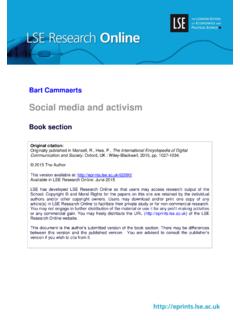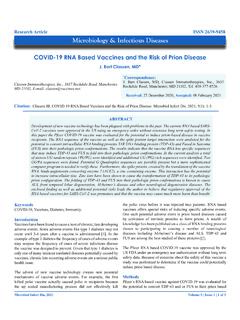Transcription of Ethnicity, Gender and Social Mobility
1 Ethnicity, Gender and Social Mobility 28 December 2016 Bart Shaw, Loic Menzies, Eleanor Bernardes and Sam Baars; LKMco Philip Nye and Rebecca Allen; Education Datalab Social Mobility Commission Sanctuary Buildings 20 Great Smith Street London SW1P 3BT 1 About the Commission The Social Mobility Commission is an advisory, non-departmental public body established under the Life Chances Act 2010 as modified by the Welfare Reform and Work Act 2016. It has a duty to assess progress in improving Social Mobility in the United Kingdom and to promote Social Mobility in England. It currently consists of four commissioners and is supported by a small secretariat. The commission board currently comprises: Alan Milburn (Chair) Baroness Gillian Shephard (Deputy Chair) Paul Gregg, Professor of Economic and Social Policy, University of Bath David Johnston, Chief Executive of the Social Mobility Foundation The functions of the commission include: monitoring progress on improving Social Mobility providing published advice to ministers on matters relating to Social Mobility undertaking Social Mobility advocacy 2 Contents Glossary.
2 1 Executive Summary .. 2 Section 1: Ethnicity, Gender and poverty - an analysis of educational performance .. 5 Gender .. 5 Gender and socio-economic status (SES) .. 8 Ethnicity .. 12 Gender and ethnicity .. 17 Ethnicity and socio-economic background .. 20 Section 2: Understanding differences in Social Mobility .. 28 The Family .. 28 Family effects on attainment .. 28 Explanations .. 28 Summary .. 32 Pre-School .. 33 Pre-school influences on early years outcomes .. 33 Explanations .. 33 Summary .. 35 School .. 36 Explanations .. 36 Higher education .. 40 Participation and achievement in Higher Education .. 40 Explanations .. 41 Summary .. 44 The Labour Market .. 45 Patterns of employment and earnings .. 45 Explanations .. 46 Summary .. 48 Conclusion .. 49 Appendix 1: Technical notes on Section 1 data.
3 58 Foundation Stage to Key Stage 5 .. 58 Foundation Stage Profile (FSP) .. 58 Key Stage 1 and 2 .. 59 At key stage two, data is used as follows: .. 59 Key stage 4 .. 59 Key Stage two to four value added .. 59 Key Stage five data .. 60 Higher Education Data .. 60 3 4 Social Mobility and Child Poverty Commission Ethnicity, Gender and Social Mobility Glossary Average Points Score (APS): A numerical value representing the overall achievement of a pupil at a particular key stage. English as an Additional Language (EAL): A term used to denote a pupil from a household where English is not the primary language used. Early Years Foundation Stage Profile (EYFSP): An assessment administered to all pupils in English schools at age 5. Free School Meals (FSM): Eligibility for FSM is a widely used proxy for low socio-economic status in English schools.
4 It is criticised for not taking into account a broad range of household circumstances, both among those eligible and non-eligible for FSM. Higher Education (HE): A term used in the UK to refer to education for young people, usually aged 18 or over, at universities and colleges, and awarding academic degrees or professional certifications. Home Learning Environment (HLE): A term used to encompass a range of factors in the home shown to be conducive to a child s learning, for example the presence of books, or parent/child reading activities. Key Stage One (KS1): Education in English schools for children aged 5-7 years. Key Stage Two (KS2): Education in English schools for children aged 7-11 years. Key Stage Three (KS3): Education in English schools for children aged 11-14 years. Key Stage Four (KS4): Education in English schools for children aged 14-16 years and which incorporates GCSEs and equivalents.
5 Key Stage Five (KS5): Education in English schools for children aged 16-18 years and which incorporates A Levels and equivalent level 3 qualifications. National Pupil Database (NPD): A record for every pupil in England held by the Department for Education (DfE). Special Educational Needs and Disabilities (SEND): A term used in England which refers to children who have additional learning needs or physical disabilities. Socio-Economic Status (SES): A term referring to the combination of education, income and occupation of an individual. Science, Technology, Engineering and Maths (STEM): A group of subjects, qualifications in which are shown to be of relative high value in the labour market. 1 Social Mobility and Child Poverty Commission Ethnicity, Gender and Social Mobility Executive Summary British families are told that if their children go to school and work hard, they will be rewarded with good jobs and opportunities.
6 But for many groups this promise is being broken. In recent months, the low educational attainment of White British boys has gained significant attention. However, when it comes to the transition from education to employment, this group is less likely to be unemployed and to face Social immobility than their female counterparts, black students and young Asian Muslims. Why is this the case? This report explores the complexities of adding ethnicity and Gender to an analysis of socio-economic Status (SES) gaps. It considers some of the ways in which Gender , ethnicity and SES interact with education to produce or reduce Social Mobility . It then explores a vast body of research into how young people s longer term Social Mobility depends on how educational outcomes at schools translate into participation and achievement in Higher Education and the labour market.
7 For each of our key findings, we recommend questions for future research and areas in urgent need of policy interventions. In Section One, we summarise trends in attainment according to Gender , SES and ethnicity and how these factors interact. We do this through new quantitative analysis of the National Pupil Database as well as by using recent research for the Department for Business, Innovation and Skills (BIS), and the Equality Challenge Unit (ECU). The literature review in Section Two then draws on quantitative and qualitative sources to explore causal factors for such gaps as well as how educational attainment translates into the labour market. Each section examines students trajectories as they progress through the early years, primary and secondary school, through to sixth form and on to university. Our unique research aims to inform the understanding of intersectionality between ethnicity, Gender and SES and further the debate by providing new insights and conclusions.
8 It sets out recommendations to Government, universities, schools and early years providers. Our analysis concludes that urgent action is needed beyond education across all sectors of the labour market and society to address the barriers young people face upon entry to the labour market. It is striking that many of the groups that either attain highest, or are improving their achievement fastest at school, are not yet able to translate educational success into labour market outcomes. This is a particular issue for some ethnic groups and women. Achievement of a good degree has a profound impact on long-term Social Mobility and there are huge differences in attainment between ethnic groups and men and women. This is particularly evident when examining the socio-economic attainment gap, which is evident from the early years. Despite recent progress, disadvantaged children fall further behind at secondary school rather than catching up.
9 These differences impact on life chances in the labour market, particularly for people from Black or Asian Muslim communities. A range of factors give rise to these differences and some require further research to understand specific issues. However, with regards to participation in the labour market, key factors include cultural, family and individual expectations, geography and direct/indirect discrimination. Meanwhile in education, differences arise from access to schools, teacher s perceptions of behaviour, parental expectations and support, and practices such as tiering and setting. Our key findings include: 1. A White British vulnerability to school underperformance. Although in every ethnic group, those eligible for Free School Meals, (FSM, a key indicator of SES), underperform compared to their 2 Social Mobility and Child Poverty Commission Ethnicity, Gender and Social Mobility more affluent peers, White British and White Other children from low income homes are the lowest performing groups at primary school.
10 White British pupils also make the least progress throughout secondary school resulting in a worsening in their performance by key stage four. The socio-economic attainment gap is largest amongst White British pupils at all Key Stages and this trend may reflect particularly wide disparities in household incomes amongst non-FSM pupils from this ethnic group. In the early years the socio-economic gap is larger for White British and White Other groups than other minority ethnic groups. Disadvantaged White British and White Other pupils are the lowest performing groups at primary and secondary school. During secondary school, disadvantaged White British pupils make slower progress and therefore fall further behind. At all key stages, these groups perform least highly of all ethnic groups in English. Until Key Stage 4 it is Other White eligible pupils who perform most poorly however at Key Stage 4 these pupils do better than their eligible White British peers.

















